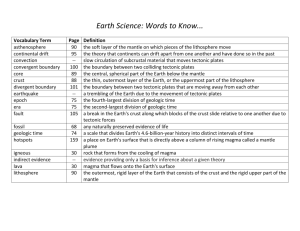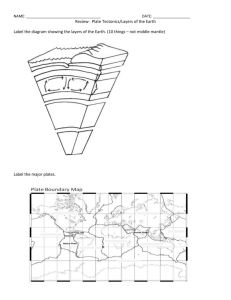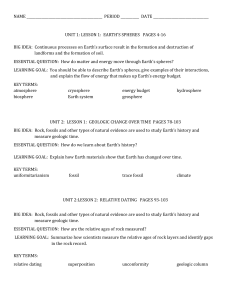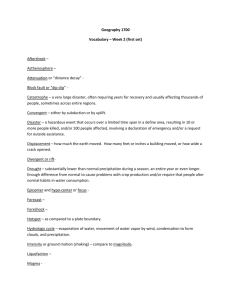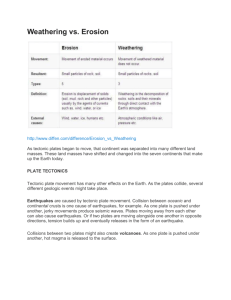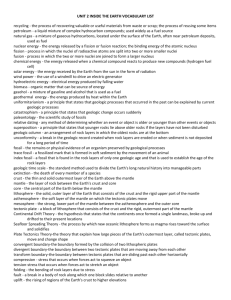7th Grade Science Unit 3: Restless Earth
advertisement
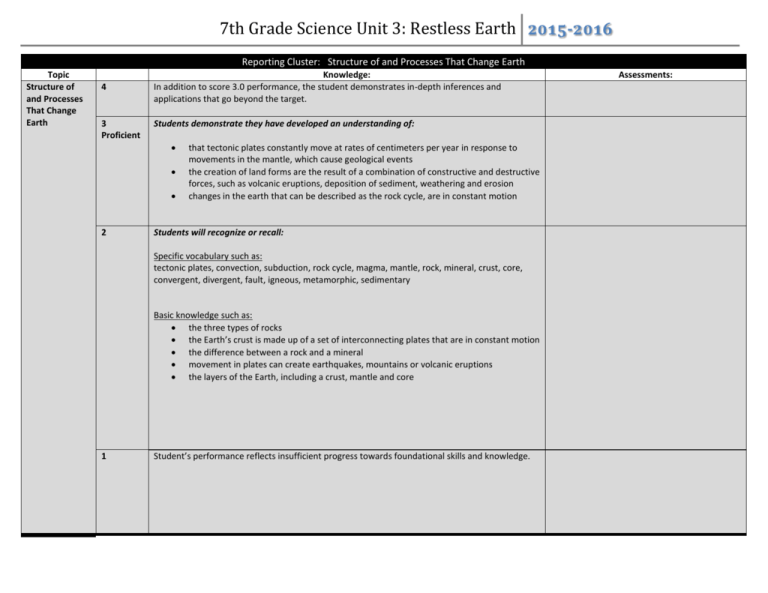
7th Grade Science Unit 3: Restless Earth 2015-2016 Reporting Cluster: Structure of and Processes That Change Earth Topic Structure of and Processes That Change Earth 4 3 Proficient Knowledge: In addition to score 3.0 performance, the student demonstrates in-depth inferences and applications that go beyond the target. Students demonstrate they have developed an understanding of: 2 that tectonic plates constantly move at rates of centimeters per year in response to movements in the mantle, which cause geological events the creation of land forms are the result of a combination of constructive and destructive forces, such as volcanic eruptions, deposition of sediment, weathering and erosion changes in the earth that can be described as the rock cycle, are in constant motion Students will recognize or recall: Specific vocabulary such as: tectonic plates, convection, subduction, rock cycle, magma, mantle, rock, mineral, crust, core, convergent, divergent, fault, igneous, metamorphic, sedimentary Basic knowledge such as: the three types of rocks the Earth’s crust is made up of a set of interconnecting plates that are in constant motion the difference between a rock and a mineral movement in plates can create earthquakes, mountains or volcanic eruptions the layers of the Earth, including a crust, mantle and core 1 Student’s performance reflects insufficient progress towards foundational skills and knowledge. Assessments: 7th Grade Science Unit 3: Restless Earth 2015-2016 Reporting Cluster: Reporting Structure Cluster:Reporting of Structure and Processes Cluster: of andThat Processes Structure Changeof That Earth and Change Processes EarthThat Change Earth Topic History of Earth Knowledge: Knowledge: Knowledge: 4 In addition to score 3.0 performance, the student demonstrates in-depth inferences and applications that go beyond the target. 3 Proficient Students demonstrate they have developed an understanding of: 2 the earth processes we see today are similar to those that occurred in the past why fossils provide important evidence of how life and environmental conditions have changed the fossil record as an incomplete record of life on Earth the evidence supporting major extinction events and the causes Students will recognize or recall: Specific vocabulary such as: fossil, Pangaea, Geologic Time Scale, extinct, relative age, absolute age, radioactive dating, continental drift Basic knowledge such as: Earth’s history has been influenced by occasional catastrophes such as the impact of an asteroid or a comet the Earth is constantly changing most living things do not become fossils fossils help scientists determine what past life and climate were like the continents are in constant motion the difference between relative and absolute age 1 Student’s performance reflects insufficient progress towards foundational skills and knowledge. Assessments: R Assessments Assessments:Assessments: 7th Grade Science Unit 3: Restless Earth 2015-2016 Suggested Instructional Resources Sample Learner Objectives Topic Textbook Resources Labs PBL Ideas (projects) Web Resources – websites or resources on http://science.dmschools.org I Can: use data sets and/or maps that show patterns (location and frequency) of earthquakes, volcanic eruptions and tsunami events in a region to predict the likelihood of future geologic events. use plate tectonic models to support the explanation that, due to convection, matter cycles between Earth’s surface and deep mantle. explain the chemical and physical processes that form rocks and minerals and cycle Earth’s materials. give evidence to defend the claim that the Earth’s continents were once connected and are in constant motion. construct scale models of the geologic time scale to determine the relative ages of a sequence of events. use geologic evidence to determine the relative ages of a sequence of events Structure of and Processes That Change Earth History of Earth 7th Grade Science Unit 3: Restless Earth 2015-2016 that occurred in the Earth’s past. use evidence from the rock and fossil record to explain how past changes in Earth conditions have caused major extinctions of some life forms and have allowed others to flourish. construct explanations for why most individual organisms, as well as some entire species, that lived in the past were never fossilized


